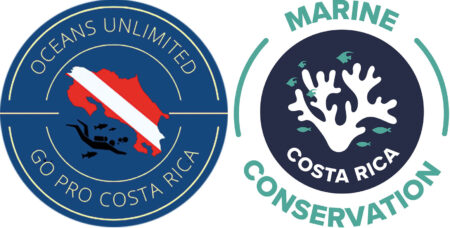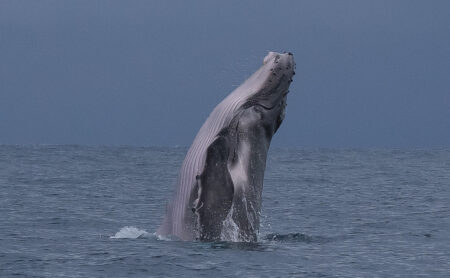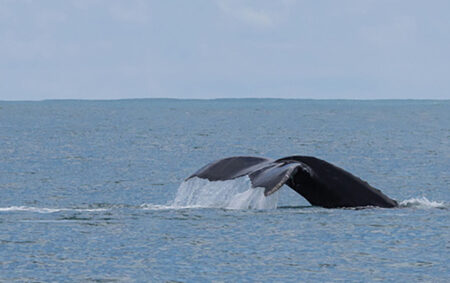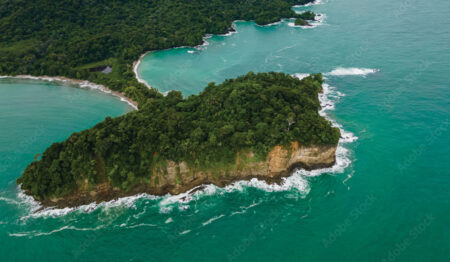Majestic Giants of the Pacific – Humpback Whales in Manuel Antonio
 Costa Rica is renowned for its breathtaking biodiversity, and one of the most awe-inspiring marine wonders that grace its coastal waters is the magnificent humpback whale. These majestic giants, known for their acrobatic displays and haunting songs, are an exciting addition to our local marine encounters. We are always looking forward to our boat trips this time of year, with the prospect of a humpback sighting on many trips. So, this month, we decided to look at some fun facts about humpback whales. We are also going to share with you some of the rules and regulations regarding responsible whale watching in Costa Rica. These incredible animals are endangered, and it is extremely important that we observe them responsibly and respectfully.
Costa Rica is renowned for its breathtaking biodiversity, and one of the most awe-inspiring marine wonders that grace its coastal waters is the magnificent humpback whale. These majestic giants, known for their acrobatic displays and haunting songs, are an exciting addition to our local marine encounters. We are always looking forward to our boat trips this time of year, with the prospect of a humpback sighting on many trips. So, this month, we decided to look at some fun facts about humpback whales. We are also going to share with you some of the rules and regulations regarding responsible whale watching in Costa Rica. These incredible animals are endangered, and it is extremely important that we observe them responsibly and respectfully.

Fun Facts about Humpback Whales
They are an impressive size and weight
Humpback whales are among the largest creatures on Earth. They can grow up to 50 feet in length and weigh around 40 tons, which is equivalent to about eight elephants! Despite their massive size, they are incredibly agile and can breach completely out of the water, putting on a breathtaking show for anyone lucky enough to
They migrate great distances
These awe-inspiring marine mammals undertake one of the longest migrations of any species, traveling up to 16,000 miles each year. Humpback whales visit Costa Rica’s warm waters during their winter breeding and calving season, making it an excellent destination for whale watching. This time of year they are visiting us from southern waters.
They have distinctive songs
Male humpback whales are renowned for their mesmerizing songs, which can last up to 20 minutes and be heard over great distances. These songs are believed to play a role in courtship and communication between whales. When scuba diving here during this time of year, sometimes we are lucky enough to hear them during the dives.

They communicate by slapping their fins
Humpback whales are known for “flipper slapping.” They raise one or both of their massive pectoral fins above the water and then forcefully slap them against the surface, creating loud splashes. Scientists speculate that this behavior might be a way of communication or self-expression.
They can be identified by their tails
Humpback whales each have unique patterns on their tail flukes. These act much like fingerprints in humans. Researchers use these distinctive markings to identify individual whales, track their migrations, and study their behavior and population dynamics.
So, what do you need to know before you head out?
Whale watching is an incredible experience, but it must be done responsibly and in accordance with Costa Rican law to ensure the well-being of these amazing creatures. The Costa Rican government has established strict regulations to protect humpback whales and their habitat. Responsible tour operators in the area follow these rules, but it also helps if you are aware of them. Here are some of the regulations, so that you can know what to expect if you decide to join us on the ocean.
Maintain a Safe Distance
Boats must stay at least 200 meters (approximately 656 feet) away from the whales. Boats that Approach too closely could disrupt their natural behaviors and cause unnecessary stress to them.
Boats must never chase or encircle the whales, as this can disrupt their natural movements and feeding patterns. Harassing or intentionally disturbing the whales is strictly prohibited.
Engine Shutdown
When in the vicinity of whales, boat captains must turn off their engines or keep them in neutral to avoid potential collisions and reduce noise pollution.
Time Limits
Whale watching encounters should be limited to a maximum of 30 minutes. This ensures that the whales are not overwhelmed by human presence and can continue with their natural behaviors. We know you are absolutely enthralled by what you see, but remember they are in their natural habitat, sometimes accompanied by young whales. It is therefore very important we don’t cause too much disruption.
Witnessing humpback whales in their natural habitat here in Manuel Antonio is an awe-inspiring experience. By following these regulations and behaving responsibly during whale-watching tours, we can ensure that these magnificent creatures will continue to return. Make sure you bring your camera and binoculars to capture the amazing experience and choose a responsible tour operator to take you on an exciting adventure to see these majestic giants.
If you want to learn more, we offer Humpback whale awareness workshops and short courses through Marine Conservation Costa Rica. We look forward to seeing you out on the ocean!

